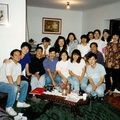During one of my first visits to the city of Manaus in the early 1990s, I was hosted by a Japanese language school in an area bordering the jungle called Cachoeira Grande (big waterfall). Manaus is a major capital city on the Amazon River. When I think of Manaus, there will always be scattered images and memories. Manaus is hazy, like a dream you’d rather forget. It’s a contrast between the raw natural beauty of the Amazon jungle and river against the elegant grandeur of the Manaus Opera House.

John Katagi, outside Manaus International Airport in October 2009. The temperature is 100 degrees and he doesn’t have the sense to take off his jacket.
In my homestay on the edge of Cachoeira Grande, the jungle was beautiful and enchanting. As the sun began to set, I wandered out of the host family’s home to look at the large marsh that surrounded the grounds of the Japanese language school they were building.
The school was on what appeared to be an island.
I took three steps out of the back door when my host, anticipating perhaps my plan to walk to the water’s edge, casually advised me not to get too close to the water. “Tem jacaré, ali perto.” (There are jacaré close by.)
Jacaré are the equivalent of small alligators found in the wetlands of Brazil. Needless to say, I didn’t need another word. I backtracked, following in my own footsteps, thinking that the better option was to stay inside the house where there were walls that would separate me from any alligators.
That evening would include an uncomfortable dinner for me as large bullfrogs serenaded us. We sat in a screen-enclosed back porch/laundry room, which they used as a makeshift dining area. All four table legs were standing in coffee cans filled with a water and oil mixture. I was told that this kept the insects from climbing from the floor onto the table. That, of course, didn’t explain the number of flies that were making aircraft carrier landings on my food. And then there was a frog trapped somewhere in a nearby washing machine that had its voice amplified in the hollowness of the iron tank. It was surreal!
Above my head were a bunch of bananas tied to a string, hanging from a hook on the ceiling. The bananas were hung from the ceiling with the intention that insects wouldn’t get to them. Upon closer inspection of the whole hanging setup, the string that I thought was black was not black because of the string color; it was black because ants were using the string as a super highway to and from the bananas. Hmm. Your clever plan does not seem to be working!
Let’s get back to the frogs on the floor. Why were there frogs on the floor? I mean other than the fact that we were in the jungle. The frogs were on the floor—are you ready?—because they were patiently and expectantly waiting for any cockroaches that would fall from their perch on the ceiling. On the ceiling!!
Periodically the cockroaches would lose their grip and fall to the ground. The frogs were precisely positioned to pounce on them when they hit the floor. Remember that this is all going on while I’m trying to have dinner.
I remember guardedly leaning over my meal so those cockroaches would not fall into my food. It became apparent as I finished my miso soup that something wasn’t quite right. The soup was cloudy (as miso soup generally is). But as I sorted through the cloudiness, I found two or three ants on the bottom of my soup bowl. Amazon sized ants!
About that time, a huge red welt appeared on my arm. It was about two inches wide and ran down my inner arm from my elbow to my wrist. To this day I have no idea where that came from. Maybe it was the stress of alligators outside the door, the ants secreting their toxins into my soup, or falling cockroaches and some crazy bullfrog serenade.
By this time, the stress had so tired me out, I was ready to go to sleep. I was told by my host that the guest quarters had air conditioning. It was 11:30pm and about ninety degrees outdoors with one-hundred percent jungle humidity. After saying goodnight to my host, and left to myself, my first task was to turn on the air conditioning unit in my room. The fan blew air, but it was hot air. What?? “I don’t want hot air,” I screamed inside my head. I turned the thermostat to “cold” (frio) and it still blew hot air. Sweat began to trail down my chest and my back just trying to get the A/C to work.
The next day my host explained that the region experienced many electrical spikes and brownouts. He guessed that the reason the A/C didn’t work was due to all the undulations in power, it was likely that the chiller motor had burned out. There would be no air conditioning for the duration of my stay in Manaus.
Somewhere in the middle of that experience, I was reminded that I was at heart a North American city boy and a spoiled one at that.
© 2010 John Katagi








